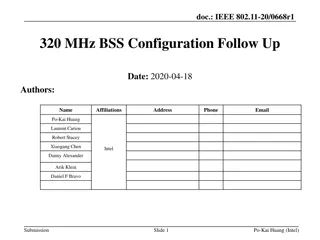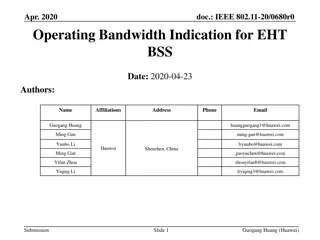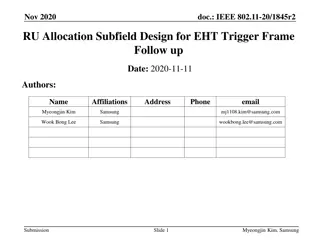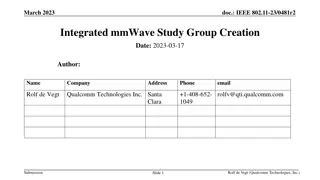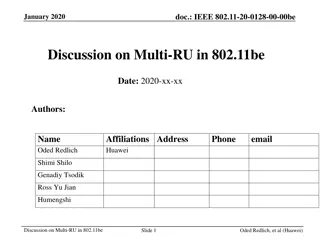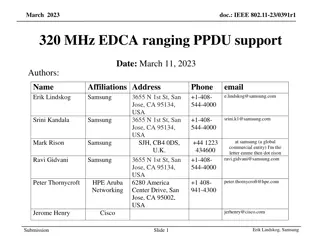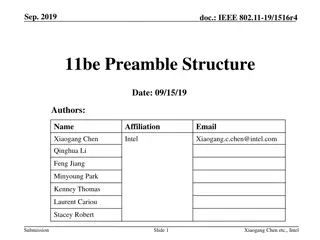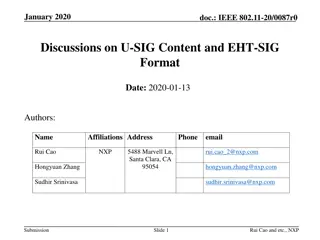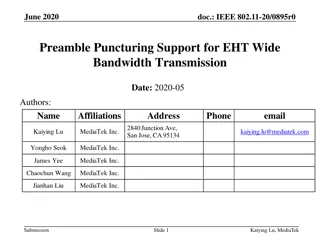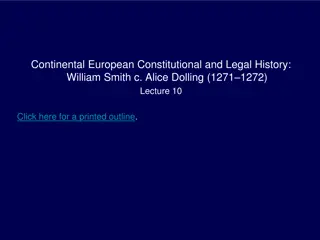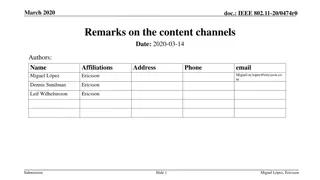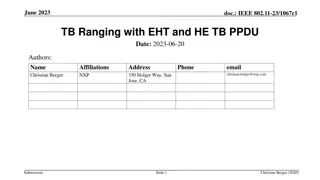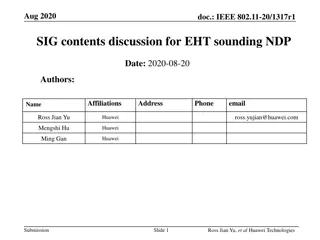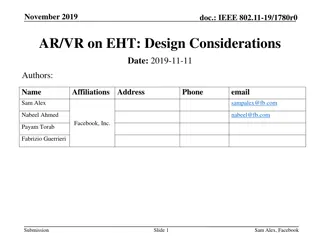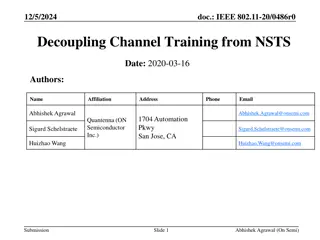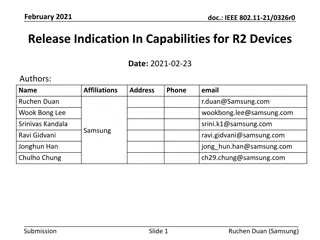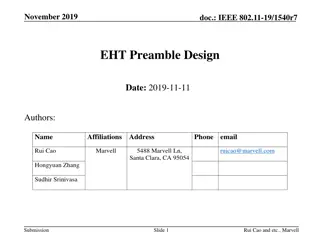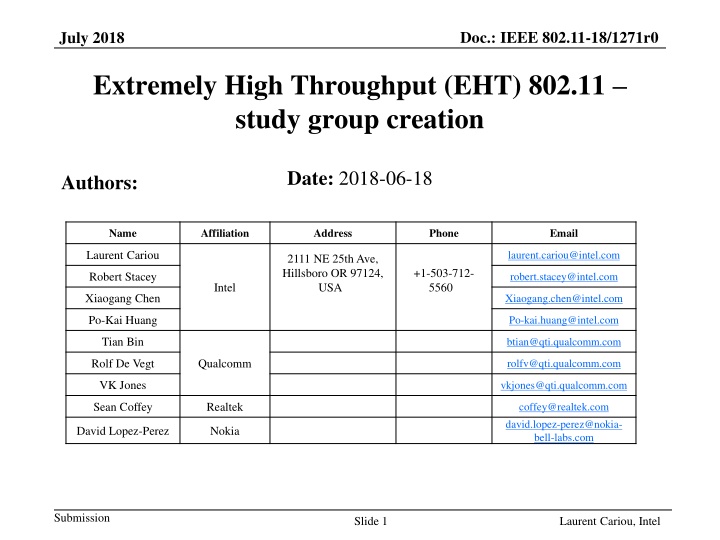
IEEE 802.11-18/1271r0 Study Group Creation for Enhanced Throughput
In July 2018, the IEEE 802.11 study group was set up to explore Extremely High Throughput (EHT) with features like 320MHz bandwidth, multiband aggregation, and 16 spatial streams. The group aims to enhance peak throughput on bands between 1 and 7.125 GHz, discussing applications like video-over-WLAN, AR, and VR. The process involves creating an XT TIG for initial discussions before transitioning to a study group for further development.
Download Presentation

Please find below an Image/Link to download the presentation.
The content on the website is provided AS IS for your information and personal use only. It may not be sold, licensed, or shared on other websites without obtaining consent from the author. If you encounter any issues during the download, it is possible that the publisher has removed the file from their server.
You are allowed to download the files provided on this website for personal or commercial use, subject to the condition that they are used lawfully. All files are the property of their respective owners.
The content on the website is provided AS IS for your information and personal use only. It may not be sold, licensed, or shared on other websites without obtaining consent from the author.
E N D
Presentation Transcript
Doc.: IEEE 802.11-18/1271r0 July 2018 Extremely High Throughput (EHT) 802.11 study group creation Date: 2018-06-18 Authors: Name Affiliation Address Phone Email Laurent Cariou laurent.cariou@intel.com 2111 NE 25th Ave, Hillsboro OR 97124, USA +1-503-712- 5560 Robert Stacey robert.stacey@intel.com Intel Xiaogang Chen Xiaogang.chen@intel.com Po-Kai Huang Po-kai.huang@intel.com Tian Bin btian@qti.qualcomm.com Rolf De Vegt Qualcomm rolfv@qti.qualcomm.com VK Jones vkjones@qti.qualcomm.com Sean Coffey Realtek coffey@realtek.com david.lopez-perez@nokia- bell-labs.com David Lopez-Perez Nokia Submission Slide 1 Laurent Cariou, Intel
Doc.: IEEE 802.11-18/1271r0 July 2018 In May, we agreed to create a study group on EHT During the May meeting, we proposed the creation of a study group to increase peak throughput with the following features: 320MHz, multiband aggregation and 16 spatial streams. Document 789r10 (https://mentor.ieee.org/802.11/dcn/18/11-18-0789-10- 0wng-extreme-throughput-802-11.pptx) is describing the proposed scope. A strawpoll was run in the WNG session (96 Y, 1 N, xx A): Do you agree to start a study group to define new features of 802.11 on bands between 1 and 7.125 GHz with the primary objective to increase peak throughput with the following candidate features: 320MHz bandwidth, multiband aggregation and operation, and 16 spatial streams. In addition, The study group will discuss high throughput applications such as video-over-WLAN, AR and VR The study group may discuss additional objectives and features. Final set of features shall be determined within 6-months, which should be also the maximum duration of study group. The study group may define procedural enhancements to make 802.11 standards development more efficient and scalable. Submission Slide 2 Laurent Cariou, Intel
Doc.: IEEE 802.11-18/1271r0 July 2018 We motioned the creation of a TIG to initiate discussion in July A TIG was then created to initiate discussion (as a study group can not be created during interims) Approve formation of an XT TIG to initiate discussion on new 802.11 features for bands between 1 and 7.125 GHz: with the primary objective to increase peak throughput candidate features include but are not limited to: 320 MHz bandwidth, multiband aggregation and operation, and 16 spatial streams, as described in https://mentor.ieee.org/802.11/dcn/18/11-18- 0789-10-0wng-extreme-throughput-802-11.pptx. To support high throughput applications such as video-over-WLAN, AR and VR Submission Laurent Cariou, Intel
Doc.: IEEE 802.11-18/1271r0 July 2018 TIG discussions during July meeting This TIG is a way to initiate study group discussion during the July meeting, with the promise that it will transition into a SG at the end of the July meeting We should then have discussion as if we were in a study group We should start discussing PAR and CSD The motion to create the study group is a formality that we need to do during the July meeting Submission Laurent Cariou, Intel
Doc.: IEEE 802.11-18/1271r0 July 2018 Accelerated process for EHT Assuming there is working group consensus to accelerate standards development timelines and target a rapid succession of 2/3 year cycle time for mainstream MAC/PHY projects, EHT should be the first candidate project for this approach 11-18-1259-00-0000-a-cascading-process-for-major-amendments.pptx, Robert Stacey 11-18-1284-00-0000-a proposed way forward, Osama Aboul-Magd Looking at industry interoperability certification launches, we should have approximately 11ax wave 1 in 2019, 11ax wave 2 around 2021. EHT would naturally be 2023 EHT should define features for a single certification program and not 2, as was done for 11ac and 11ax, so its scope should be scaled accordingly A new project would start 2 to 2 years from now to define 2025-2026 release. In order to succeed with this approach, we need: To be very strict in defining and respecting the timelines To focus on the key features that show significant gains towards the objective of the project, and to list them Potentially to provide visibility on the future projects, by providing a pre-list of features that would be considered for the project immediately following EHT Submission
Doc.: IEEE 802.11-18/1271r0 July 2018 EHT timeline/roadmap July 2018: creation of EHT SG Best option for start of EHT TG: Jan 2019 Next possible start time of EHT TG: May 2019 Submission Slide 6 Laurent Cariou, Intel
Doc.: IEEE 802.11-18/1271r0 July 2018 Possible timeline for EHT with 2.5 years cycle 11ax D1.0 2019 Certification launch: 11ax R1 ??? 11ax R1 802.11 EHT TG Industry certification program 2021 Certification launch: 11ax R2 ??? ??? 11ax R2 Industry certification program End 2023 Certification launch EHT D2.0 EHT D1.0 EHT 802.11 EHT TG Industry certification program S2 22 S1 23 S2 23 S2 19 S1 20 S2 20 S1 18 S2 18 S1 19 S1 21 S2 21 S1 22 S1 17 S2 17 Submission Slide 8 Laurent Cariou, Intel
Doc.: IEEE 802.11-18/1271r0 July 2018 EHT timeline/roadmap We believe we should start TG in January 2019 That gives us 2 to 2 years to reach D1.0 2 years cycle: D1.0 needs to be ready for Q4 2020 2 years cycle: D1.0 needs to be ready for Q2 2021 Starting in May 2019 is putting these cycles in jeopardy Features that are agreed can be listed in the scope of the PAR The 3 features listed today don t require further studies and are providing sufficient gains to have insurance to meet an ambitious PAR Features that are identified as interesting but require more studies can be listed as being under study/consideration We can use the 4 months between September and January to discuss them, as well as during the initial TG phase Example: Multi-AP time and frequency coordination EHT should define features for a single certification program and not 2, contrary to what was done for 11ac and 11ax, so its scope should be scaled accordingly Submission Slide 8 Laurent Cariou, Intel
Doc.: IEEE 802.11-18/1271r0 July 2018 Motion to create EHT Study group Motion is a formality that we need to do in July. Following the agreement we reached in May, we can easily define the motion text to create the study group by adapting the TIG motion into a SG motion Next slide defines this baseline motion proposal This is the baseline proposal that is agreed by all as an outcome of the May meeting During the July meeting, we can further discuss and have presentations in order to see if we can have a scope that is even more precise and if we can have a motion text even more precise If we need more time for this, we fall back naturally to the baseline motion proposal The important document is anyway the PAR and CSD documents Submission Laurent Cariou, Intel
Doc.: IEEE 802.11-18/1271r0 July 2018 Original proposed motion for EHT study group Based on TIG formation agreement Approve the formation of the 802.11 Extremely High Throughput (EHT) study group to consider development of a Project Authorization Request (PAR) and Criteria for Standards Development (CSD) for 1 to 7.125 GHz operation With the primary objective of increasing peak throughput to support high throughput applications such as video-over-WLAN, AR and VR. Candidate features include but are not limited to: 320 MHz bandwidth, multiband aggregation and operation, and 16 spatial streams, as described in https://mentor.ieee.org/802.11/dcn/18/11-18-0789-10-0wng-extreme-throughput- 802-11.pptx. Submission Laurent Cariou, Intel
Doc.: IEEE 802.11-18/1271r0 July 2018 Updated motion for EHT study group Based on discussion this week Approve the formation of the 802.11 Extremely High Throughput (EHT) study group to consider development of a Project Authorization Request (PAR) and Criteria for Standards Development (CSD) for 1 to 7.125 GHz operation With the primary objective of increasing peak throughput to support high throughput applications such as video-over-WLAN, AR and VR. Candidate features include but are not limited to: 320 MHz bandwidth, multiband aggregation and operation, 16 spatial streams, as described in https://mentor.ieee.org/802.11/dcn/18/11-18-0789-10-0wng-extreme-throughput- 802-11.pptx and Multi-AP coordination Submission Laurent Cariou, Intel

